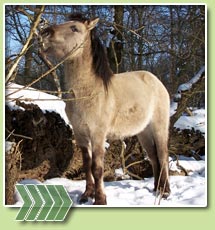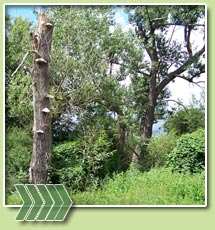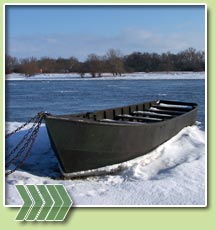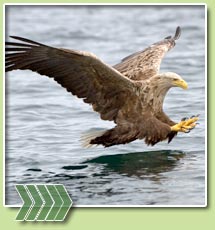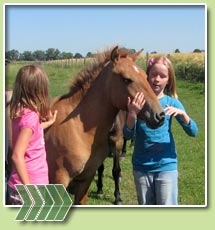Wilderness around the Elbe River
Intact flood plains with their typical seasonal changeover of ice, high and low water are the modern ark of Noah. Plain forests and grasslands, mighty loops of the river, oxbow lakes, brackish waters, potholes, as well as the sand valley edges surrounded by inland dunes – no other ecosystem in middle Europe hosts a similar habitat and biodiversity. Over 12,000 different animals and plants are found in this region. Among them are a lot of rarities.
They reach from the ''Big Five'' of the Elbe River – beaver, otter, stork, crane and eagle – to the stag beetle and the scarce large blue butterfly.
The flood plains are deeply connected with the grazing fields. The large scale seasonal animal migration in the prehistoric era tied the plains as winter quarters with the joining lowlands and mountains. Forest elephants, wool rhinoceroses, hippopotamuses, water buffaloes, mooses, as well as aurochs' and wild horses were inhabited in the flood plains of middle Europe. The big grazers formed the landscape and made their own world, as they walked along the plains, rolled and wallowed in the mud holes, spread the seeds and fruits of plants and at last gave a lot of destruents, such as insects and fungi, a home by contributing their dung to the open grassland.
Today modern nature conservation connects the dynamics of the plains located in the large-scale grazing grounds with the dynamics of the big grazers' actions. To develop the landscape, there are used cultivated portrays of the extinct wild forms of aurochs (European wild cattle; extinct 1627) and the western wild horse (Tarpan; extinct around 1918). The water buffaloes, which have been domesticated for 7,000 years in Asia and were widespread in Germany until the 12th century, plus the Galloway-Cattle, descendant from southern Scotland, are used preferably in the moist regions. There is also used a cultivated horse called “Exmoor-Pony“ from South of England for the portray of the Tarpan. Those new cultivated herds live in specified native social bounds.
Wild hog, deer and “Elbe”-beaver complete the community of the big herbivores.
The NABU-Elbecenter has established two big grazing plains in the nature reserves of “Elsholzwiesen bei Buch” and “Bucher Brack bei Jerichow”. Observation towers enable visitors to experience amazing views. Those are not interfering with the animal world in the plains. A petting field next to the town of Buch allows the immediate contact with the animals. Within the motto „Wilde Landschaft – KOSTbar“ (wild landscape – delicious) you are able to enjoy the culinary BIO-specialities of our Galloway-cattle.
Gladly we will give you a personal tour into the wilderness; on foot, charabanc, on the bicycle, on a rubber raft or a fisher's boat.
We dearly invite you to experience the wild biosphere reservation at the middle Elbe river.

